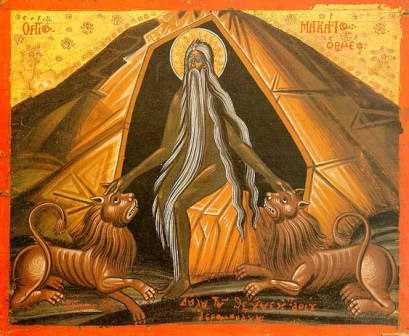Holy Apostle James the Brother of the Lord
Holy Apostle James, the Brother of God (Adelphotheos) was the son of Righteous Joseph the Betrothed of the Most Holy Theotokos (December 26). From his early years James was a Nazarene, a man especially dedicated to God.
The Nazarenes vowed to preserve their virginity, to abstain from wine, to refrain from eating meat, and not to cut their hair. The vow of the Nazarenes symbolized a life of holiness and purity, commanded formerly by the Lord for all Israel.
When the Savior began to teach the nation about the Kingdom of God, Saint James believed in Christ and became His apostle. He was chosen as the first Bishop of Jerusalem.
Saint James presided over the Council of Jerusalem and his word was decisive (Acts 15). In his thirty years as bishop, Saint James converted many of the Jews to Christianity. Annoyed by this, the Pharisees and the Scribes plotted together to kill Saint James.
They led the saint up on the pinnacle of the Jerusalem Temple and asked what he thought of Jesus. The holy Apostle began to bear witness that Christ is the Messiah, which was not the response the Pharisees were expecting. Greatly angered, the Jewish teachers threw him off the roof.
The saint did not die immediately, but gathering his final strength, he prayed to the Lord for his enemies while they were stoning him. Saint James’ martyrdom occurred about 63 A.D.
The holy Apostle James composed a Divine Liturgy, which formed the basis of the Liturgies of Saints Basil the Great and John Chrysostom. The Church has preserved an Epistle of Saint James, one of the books of the New Testament.
In 1853, Patriarch Hierotheus of Alexandria sent to Moscow a portion of the relics of Saint James. The Church distinguishes between the holy Apostle James the Brother of God, and Saint James the son of Zebedee (April 30) and Saint James the son of Alphaeus (October 9).
Troparion – Tone 4:
As the Lord’s disciple you received the Gospel, O righteous James; as a martyr you have unfailing courage; as God’s brother, you have boldness; as a hierarch, you have the power to intercede. Pray to Christ God that our souls may be saved.

St. Macarius the Roman of Mesopotamia
One day, the cave where holy ascetic Makarios lived was found by three monks from the Monastery of Saint Asclepius in Mesopotamia. Sergius, Hyginos and Theophilos had left the monastery in order to wander through the world, seeking a sign from God which would be beneficial for their salvation.
Suddenly, as they approached the cave, they noticed a marvelous fragrance issuing forth from it. Then they saw an old man walking toward them, covered only by his hair and a beard which reached his knees.
He threw himself to the ground and remained there for several minutes, until he was sure the three strangers were not really demons. When he was satisfied that he was not experiencing some sort of delusion, he invited them into his cave. The oldest monk asked him to relate his story, which he did.
Saint Makarios told them that he was born in Rome and was the son of a wealthy Senator named John. When he was old enough to be married, his parents betrothed him against his will.
There was a celebration following the wedding, but instead of entering the bridal chamber, he fled to the home of a pious widow, where he spent seven days secretly weeping and entreating God to help him. When he left her house, Makarios met a well-dressed old man of noble demeanor.
This man ordered Makarios to accompany him. Makarios did follow him for three years, until one day they came to a cave, and then the old man vanished. He appeared to Makarios in a dream soon afterward and revealed that he was the Archangel Raphael, who had guided Tobias in his travels. Before he vanished, the Archangel entrusted him to God’s mercy.
Soon after he first moved into the cave, Makarios saw a most beautiful young woman standing before him, who said that she also had fled from an unwanted marriage in Rome.
In spite of his caution, Saint Makarios did not have sufficient discernment to escape the devil’s snare, and so he allowed the girl to spend the night in his cave. For the first time in his life, he was assaulted by the fiery darts of carnal desire, and he sinned with the girl. Suddenly she disappeared, and the devil rejoiced because he had tempted the ascetic to sin.
At that moment Saint Makarios realized the seriousness of his fall. Weeping bitterly, he decided to leave the cave and find another place where he might do penance. Along the way, the Archangel Raphael appeared to him once again and urged him to return.
He told him that God would hear his prayers if he remained in the cave. So he went back and subjected his flesh to severe fasting, vigils and absolute self-denial for many years, so that he might recover the purity of his soul in order to contemplate God.
After he had edified the three brethren with the story of his struggles, Saint Makarios sent them on their way in peace. His sin was very great, but so was his repentance; therefore, he fell asleep in the Lord in the presence of the angels and the saints.
The precise date of the saint’s repose is not known, but it was probably at the end of the fourth century, or the beginning of the fifth.
Troparion – Tone 8:
By a flood of tears you made the desert fertile, and your longing for God brought forth fruits in abundance. By the radiance of miracles you illumined the whole universe! O our holy father Macarius, pray to Christ our God to save our souls!







